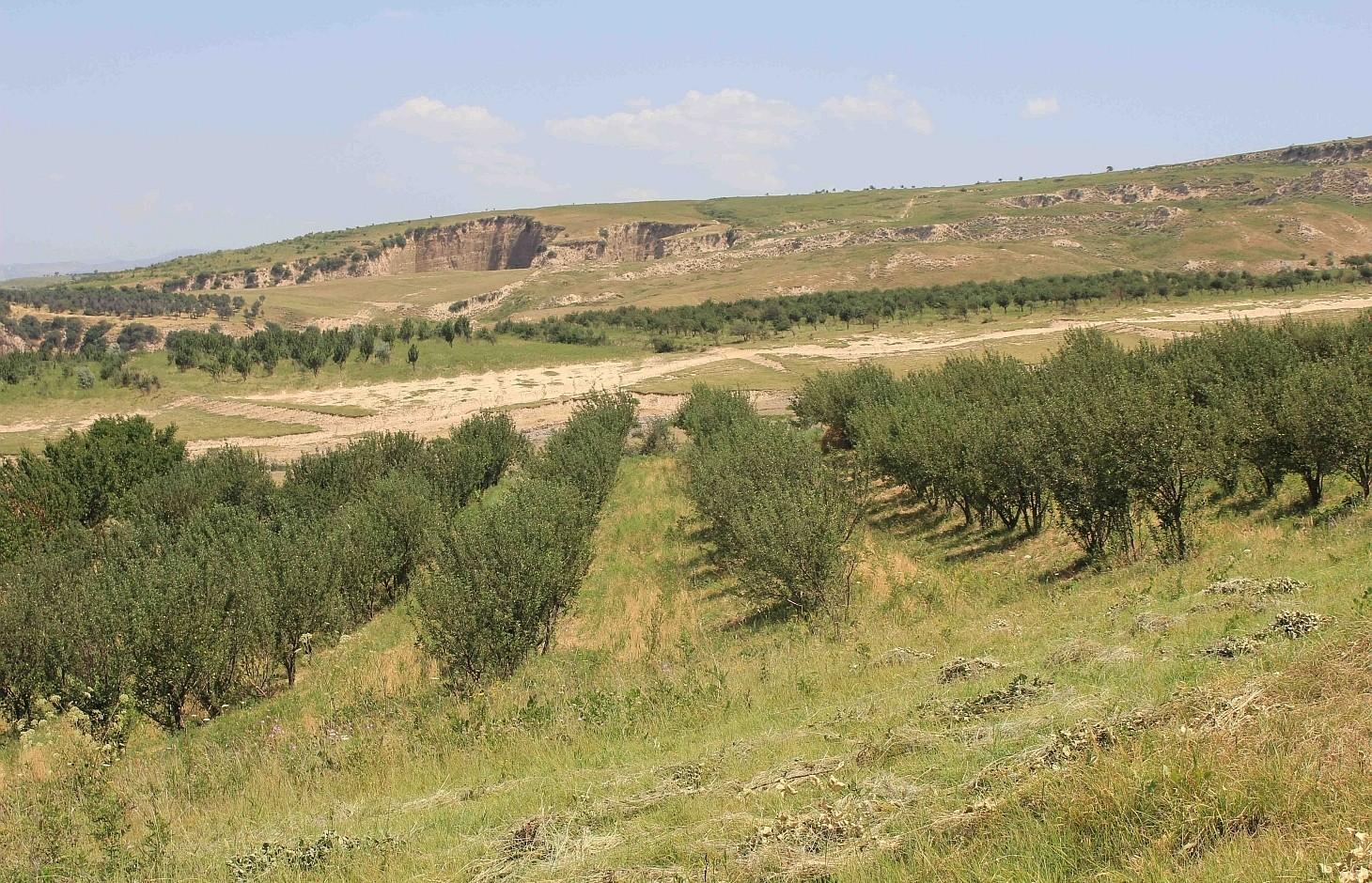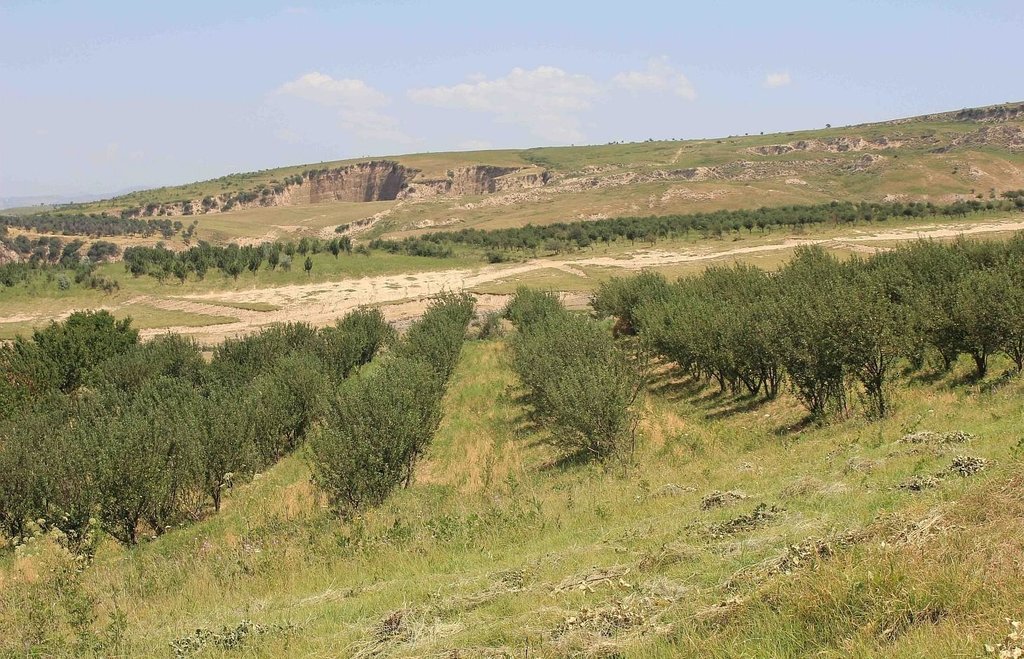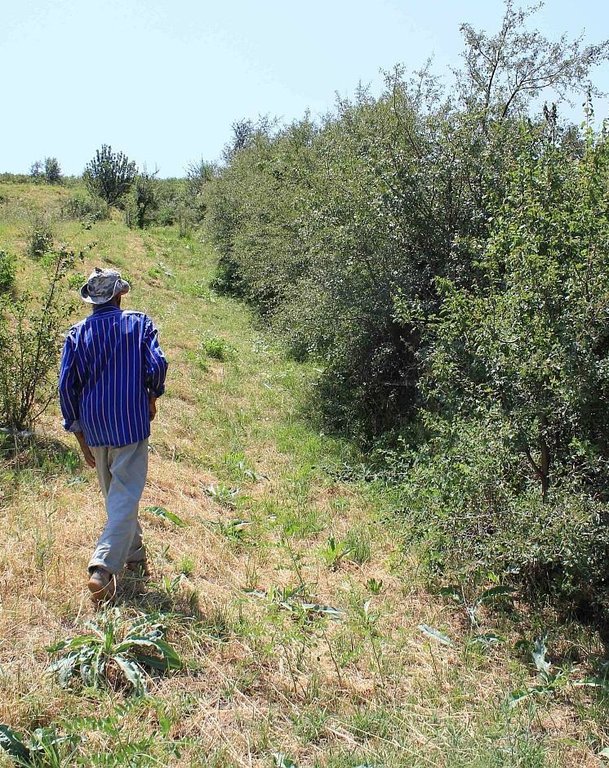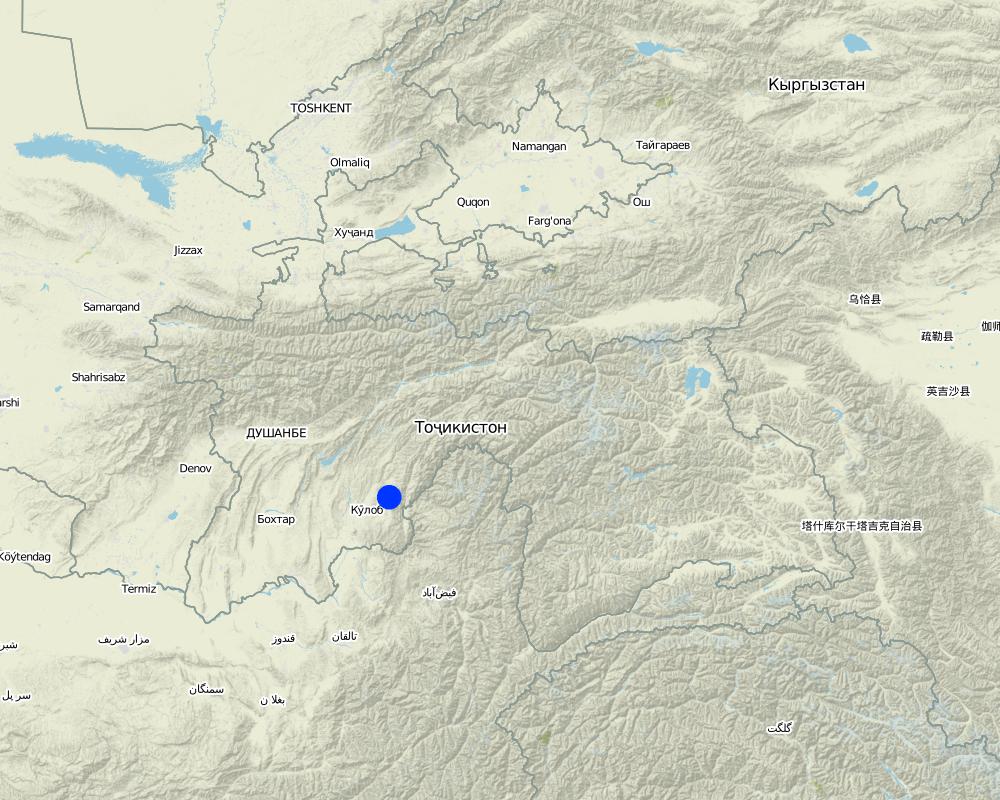Mixed fruit tree orchard with intercropping of Esparcet and annual crops in Muminabad District [Tajikistan]
- Creation:
- Update:
- Compiler: Malgorzata Conder
- Editor: –
- Reviewers: Laura Ebneter, Alexandra Gavilano, Fabian Ottiger
Bog
technologies_1128 - Tajikistan
- Full summary as PDF
- Full summary as PDF for print
- Full summary in the browser
- Full summary (unformatted)
- Mixed fruit tree orchard with intercropping of Esparcet and annual crops in Muminabad District: Dec. 28, 2016 (inactive)
- Mixed fruit tree orchard with intercropping of Esparcet and annual crops in Muminabad District: May 31, 2017 (inactive)
- Mixed fruit tree orchard with intercropping of Esparcet and annual crops in Muminabad District: June 2, 2017 (inactive)
- Mixed fruit tree orchard with intercropping of Esparcet and annual crops in Muminabad District: Aug. 4, 2019 (public)
View sections
Expand all Collapse all1. General information
1.2 Contact details of resource persons and institutions involved in the assessment and documentation of the Technology
SLM specialist:
Name of the institution(s) which facilitated the documentation/ evaluation of the Technology (if relevant)
NCCR North-South (NCCR North-South) - KyrgyzstanName of the institution(s) which facilitated the documentation/ evaluation of the Technology (if relevant)
CARITAS (Switzerland) - Switzerland1.3 Conditions regarding the use of data documented through WOCAT
The compiler and key resource person(s) accept the conditions regarding the use of data documented through WOCAT:
Yes
2. Description of the SLM Technology
2.1 Short description of the Technology
Definition of the Technology:
Orchard based agroforestry established on the hill slopes of Muminabad
2.2 Detailed description of the Technology
Description:
Between 1993 and 94 an individual farmer initiated an orchard by planting a mix of fruit trees, such as apricots, walnuts, cherries, almonds and mostly apple trees in the rainfed hill zones of Muminabad District.
In the first couple of years 416 newly planted seedlings were watered manually: water was brought by trucks near to the plot and distributed to the seedlings with buckets. The orchard was established on the existing grazing land and therefore the seedlings had to be secured with a fence from livestock grazing nearby. First hard wire was used for fencing. Simultaneously, hawthorns (Dulona in Tajik) were planted along the fence in order to provide even stronger protection and establish a live fence for the future. Now, the fruit trees are fully-grown and fruits can be harvested every year. The farmer prunes trees annually, which is the key for fruit production. The farmer pointed out that in rainfed areas soils contain less nutrients and usually big trees do not produce high yield. Furthermore, pruned tree branches are used as firewood. The farmer also applies the pesticides B52 and B58, three times a year in the months of April, May and June. The total area of the plot is 1.03 hectares, whereof 0.60 hectares are orchard; Esparcet is covering roughly 0.30 hectares, 0.07 hectare is for haymaking and the rest of the 0.06 hectares is used for growing chickpea and wheat. There is also a road for machinery to pass and to turn around when plowing the land.
Purpose of the Technology: Shortly after the fall of the Soviet Union, the government officials distributed land to the villagers. The farmer always had a big interest to establish a small orchard and he obtained little more than a hectare of land. It is his project for retirement. He and his family worked hard throughout the establishment phase. They experimented by planting a variety of vegetables including melons and watermelons. The wild animals ate many of the vegetables and melons, what resulted in the farmer's idea of intercropping Esparcet.
Establishment / maintenance activities and inputs: According to the farmer, the first two years were very labor intensive and crucial to establish the orchard. He also had to face a challenge posed by the community, as overnight people from the nearby villages stole roughly 100 of his newly planted seedlings. This is one of the reasons why the farmer had to plant hawthorn in order to establish a live fence. In summary: The establishment phase included planting of young seedlings; manually watering for the first two years; plowing in between the tree rows by machinery; building a fence around the plot and planting/sowing hawthorns. Maintenance activities consist of the following activities: planting new seedlings; pruning of existing trees; grafting new sorts of trees, plowing by tractor in between the tree rows annually; chickpea and wheat cultivation; application of chemical pesticides three times a year. For cutting wheat, the farmer gets support from his son and friends. Every day, he goes to his orchard, which is located at a distance of more than 1.5km from his house. When this technology was documented he was about to build a small clay hut in his orchard.
It should be noted that the terrace structure was not implemented at once, but over the years tilling in between the tree rows along the contour lines formed terrace shaped rows.
The structure of terraces has been built over the years by tilling in between tree rows along the contour lines.
Natural / human environment: Muminabad is situated in the southwest of Tajikistan (Khatlon Province) and its hills are covered by loessial soil. Winter temperatures are low and the amount of precipitation is high. Summers are very hot and dry. The growing season lasts from March/ April to September/ October.
2.3 Photos of the Technology
2.5 Country/ region/ locations where the Technology has been applied and which are covered by this assessment
Country:
Tajikistan
Region/ State/ Province:
Khatlon, Tajikistan
Further specification of location:
Muminabad
Comments:
Total area covered by the SLM Technology is 0.01 km2.
1.03 ha in total, whereof 0.6 ha is orchard
Map
×2.6 Date of implementation
If precise year is not known, indicate approximate date:
- 10-50 years ago
2.7 Introduction of the Technology
Specify how the Technology was introduced:
- through land users' innovation
3. Classification of the SLM Technology
3.2 Current land use type(s) where the Technology is applied
Land use mixed within the same land unit:
Yes
Specify mixed land use (crops/ grazing/ trees):
- Agroforestry

Cropland
- Tree and shrub cropping
Tree and shrub cropping - Specify crops:
- pome fruits (apples, pears, quinces, etc.)
- stone fruits (peach, apricot, cherry, plum, etc)
Number of growing seasons per year:
- 1
Specify:
Longest growing period in days: 180Longest growing period from month to month: April-Sept/oct
Is intercropping practiced?
Yes
If yes, specify which crops are intercropped:
wheat, chickpeas

Grazing land
Extensive grazing:
- Semi-nomadic pastoralism

Forest/ woodlands
Comments:
Major land use problems (compiler’s opinion): Soil erosion by water, heavy rainfalls, absence of vegetative cover on the hill slopes.
Major land use problems (land users’ perception): Soil erosion by water, extensive grazing, gully erosion.
3.4 Water supply
Water supply for the land on which the Technology is applied:
- mixed rainfed-irrigated
3.6 SLM measures comprising the Technology

vegetative measures
- V1: Tree and shrub cover

management measures
- M2: Change of management/ intensity level
Comments:
Type of vegetative measures: aligned: -contour
3.7 Main types of land degradation addressed by the Technology

soil erosion by water
- Wt: loss of topsoil/ surface erosion
- Wg: gully erosion/ gullying
Comments:
Main causes of degradation: soil management (Extensive grazing led to a reduction of soil cover, which is the major source of erosion), deforestation / removal of natural vegetation (incl. forest fires) (Removal of trees left the soil unprotected against precipitation and extreme weather events), over-exploitation of vegetation for domestic use (Trees were cut as firewood for fuel consumption), overgrazing, land tenure (Land abandonment after Soviet collapse), governance / institutional (Lacking istitutional support)
Secondary causes of degradation: Heavy / extreme rainfall (intensity/amounts) (More extreme rainfall events), floods (As a result of extreme events there are more floods in the region)
3.8 Prevention, reduction, or restoration of land degradation
Specify the goal of the Technology with regard to land degradation:
- prevent land degradation
- reduce land degradation
Comments:
Main goals: prevention of land degradation, mitigation / reduction of land degradation
Secondary goals: rehabilitation / reclamation of denuded land
4. Technical specifications, implementation activities, inputs, and costs
4.1 Technical drawing of the Technology
Technical specifications (related to technical drawing):
The fenced plot is mainly used for the orchard intercropped with chickpea, flax and wheat. Esparcet and grass for haymaking covers only a small part of the plot. The part on the left handside is also used to turn the tractor when ploughing, which is why this part is affected by soil erosion and rills. The whole property is fenced by hawthorns (dulona). The orchard has a terrace-like structure due to annual plowing by tractor.
Location: Sarmaydon 2. Muminabad
Technical knowledge required for field staff / advisors: moderate
Technical knowledge required for land users: moderate
Main technical functions: control of raindrop splash, control of dispersed runoff: retain / trap, control of dispersed runoff: impede / retard, improvement of ground cover, water harvesting / increase water supply, increase of biomass (quantity)
Secondary technical functions: improvement of surface structure (crusting, sealing), improvement of topsoil structure (compaction), increase in organic matter, increase / maintain water stored in soil, reduction in wind speed
Aligned: -contour
Number of plants per (ha): 416
Vertical interval between rows / strips / blocks (m): 3
Vertical interval within rows / strips / blocks (m): 3.5
Fruit trees / shrubs species: apple, apricot, pear, cherry
Other species: intercropped with chickpea and wheat
Author:
Q. Shokirov
Date:
12-07-2012
4.2 General information regarding the calculation of inputs and costs
other/ national currency (specify):
Somoni
If relevant, indicate exchange rate from USD to local currency (e.g. 1 USD = 79.9 Brazilian Real): 1 USD =:
4.83
Indicate average wage cost of hired labour per day:
12.40
4.3 Establishment activities
| Activity | Timing (season) | |
|---|---|---|
| 1. | Digging a deep barrier for protection around the plot with a bulldozer, 1 day | once (1993) |
| 2. | Plowing in between the rows by tractor, labor, petrol and rent for one day | once (1993) |
| 3. | Planting fruit trees, 3 days by 3 persons (3-5 Somoni per seedling, 3 Som/ seedling planting) | once (1993) |
| 4. | Watering young seedlings for the first couple of years by truck (60 TJS per truck) | one day a week/ 50 times a year |
| 5. | Construction of fence with hard wire and haw thorn (approx. 320m) | once |
| 6. | Buying and replanting of 100 stolen fruit seedlings | once |
4.4 Costs and inputs needed for establishment
| Specify input | Unit | Quantity | Costs per Unit | Total costs per input | % of costs borne by land users | |
|---|---|---|---|---|---|---|
| Labour | Labour | ha | 1.0 | 4629.333 | 4629.33 | 100.0 |
| Equipment | Machine use | ha | 1.0 | 227.833 | 227.83 | 100.0 |
| Equipment | Petrol | l | 20.0 | 1.14 | 22.8 | 100.0 |
| Plant material | Seedlings | Pieces | 516.0 | 0.621 | 320.44 | 100.0 |
| Construction material | Hard wire and pillars | m | 320.0 | 1.4556 | 465.79 | 100.0 |
| Total costs for establishment of the Technology | 5666.19 | |||||
| Total costs for establishment of the Technology in USD | 1173.12 | |||||
Comments:
Duration of establishment phase: 24 month(s)
4.5 Maintenance/ recurrent activities
| Activity | Timing/ frequency | |
|---|---|---|
| 1. | Tractor ploughing, labor, petrol and rent, 1-2 hours, 2 persons | spring, once a year |
| 2. | Soil loosening around trees, 5-6 days, 3-4 persons | spring, once a year |
| 3. | Pruning of the approx. 400 fruit trees (3 TJS per tree) | every year |
| 4. | Bringing water from village and watering (40 liters a day,20l on each donkey, 3 h for walking and watering) | every day |
| 5. | Applying pesticides, 1 person, 7 days (5 hours per day) | Three times a year: April, May, June |
| 6. | Sowing wheat and chickpea (1 person, 2 hours) | spring, once a year |
| 7. | Cutting wheat and chickpea (2 persons, 4 hours) | autumn, once |
| 8. | Harvesting fruit trees (3.6 TJS per fruit tree) | autumn, once a year |
4.6 Costs and inputs needed for maintenance/ recurrent activities (per year)
| Specify input | Unit | Quantity | Costs per Unit | Total costs per input | % of costs borne by land users | |
|---|---|---|---|---|---|---|
| Labour | Labour | ha | 1.0 | 4493.5 | 4493.5 | 100.0 |
| Equipment | Machine use | ha | 1.0 | 10.3 | 10.3 | 100.0 |
| Equipment | Petrol | l | 20.0 | 1.14 | 22.8 | 100.0 |
| Plant material | Pesticides | kg | 0.25 | 186.0 | 46.5 | 100.0 |
| Plant material | Seeds | pc | 1.0 | 3.7 | 3.7 | 100.0 |
| Total costs for maintenance of the Technology | 4576.8 | |||||
| Total costs for maintenance of the Technology in USD | 947.58 | |||||
4.7 Most important factors affecting the costs
Describe the most determinate factors affecting the costs:
The technology was established during the Soviet Union and most of the expenses were calculated on the price basis of that time. If technology is priced by current prices, the total sum would be very high and no farmer would be able to afford. Thus, current prices were not identified. Nowadays, machinery cost, buying hard wire for fencing and buying seedlings would be the most costly factors.
5. Natural and human environment
5.1 Climate
Annual rainfall
- < 250 mm
- 251-500 mm
- 501-750 mm
- 751-1,000 mm
- 1,001-1,500 mm
- 1,501-2,000 mm
- 2,001-3,000 mm
- 3,001-4,000 mm
- > 4,000 mm
Agro-climatic zone
- sub-humid
Thermal climate class: temperate
5.2 Topography
Slopes on average:
- flat (0-2%)
- gentle (3-5%)
- moderate (6-10%)
- rolling (11-15%)
- hilly (16-30%)
- steep (31-60%)
- very steep (>60%)
Landforms:
- plateau/plains
- ridges
- mountain slopes
- hill slopes
- footslopes
- valley floors
Altitudinal zone:
- 0-100 m a.s.l.
- 101-500 m a.s.l.
- 501-1,000 m a.s.l.
- 1,001-1,500 m a.s.l.
- 1,501-2,000 m a.s.l.
- 2,001-2,500 m a.s.l.
- 2,501-3,000 m a.s.l.
- 3,001-4,000 m a.s.l.
- > 4,000 m a.s.l.
5.3 Soils
Soil depth on average:
- very shallow (0-20 cm)
- shallow (21-50 cm)
- moderately deep (51-80 cm)
- deep (81-120 cm)
- very deep (> 120 cm)
Soil texture (topsoil):
- coarse/ light (sandy)
Topsoil organic matter:
- medium (1-3%)
5.4 Water availability and quality
Ground water table:
> 50 m
Availability of surface water:
poor/ none
Water quality (untreated):
unusable
5.5 Biodiversity
Species diversity:
- medium
5.6 Characteristics of land users applying the Technology
Market orientation of production system:
- subsistence (self-supply)
Off-farm income:
- 10-50% of all income
Relative level of wealth:
- average
Individuals or groups:
- individual/ household
Level of mechanization:
- manual work
- mechanized/ motorized
Gender:
- women
- men
Indicate other relevant characteristics of the land users:
Population density: 100-200 persons/km2
Annual population growth: 1% - 2%
40% of the land users are average wealthy.
5.7 Average area of land used by land users applying the Technology
- < 0.5 ha
- 0.5-1 ha
- 1-2 ha
- 2-5 ha
- 5-15 ha
- 15-50 ha
- 50-100 ha
- 100-500 ha
- 500-1,000 ha
- 1,000-10,000 ha
- > 10,000 ha
Is this considered small-, medium- or large-scale (referring to local context)?
- small-scale
5.8 Land ownership, land use rights, and water use rights
Land ownership:
- state
Land use rights:
- leased
Comments:
Land ownership is based on the land user certificate conferred by the government.
5.9 Access to services and infrastructure
health:
- poor
- moderate
- good
education:
- poor
- moderate
- good
technical assistance:
- poor
- moderate
- good
employment (e.g. off-farm):
- poor
- moderate
- good
markets:
- poor
- moderate
- good
energy:
- poor
- moderate
- good
roads and transport:
- poor
- moderate
- good
drinking water and sanitation:
- poor
- moderate
- good
financial services:
- poor
- moderate
- good
6. Impacts and concluding statements
6.1 On-site impacts the Technology has shown
Socio-economic impacts
Production
crop production
fodder production
fodder quality
wood production
production area
Water availability and quality
demand for irrigation water
Income and costs
expenses on agricultural inputs
farm income
diversity of income sources
workload
Socio-cultural impacts
food security/ self-sufficiency
recreational opportunities
conflict mitigation
Ecological impacts
Water cycle/ runoff
surface runoff
evaporation
Soil
soil moisture
soil cover
soil loss
soil crusting/ sealing
soil compaction
soil organic matter/ below ground C
Biodiversity: vegetation, animals
biomass/ above ground C
habitat diversity
6.2 Off-site impacts the Technology has shown
downstream flooding
buffering/ filtering capacity
6.3 Exposure and sensitivity of the Technology to gradual climate change and climate-related extremes/ disasters (as perceived by land users)
Gradual climate change
Gradual climate change
| Season | increase or decrease | How does the Technology cope with it? | |
|---|---|---|---|
| annual temperature | increase | not well |
Climate-related extremes (disasters)
Meteorological disasters
| How does the Technology cope with it? | |
|---|---|
| local rainstorm | well |
| local windstorm | well |
Climatological disasters
| How does the Technology cope with it? | |
|---|---|
| drought | not well |
Hydrological disasters
| How does the Technology cope with it? | |
|---|---|
| general (river) flood | not well |
6.4 Cost-benefit analysis
How do the benefits compare with the establishment costs (from land users’ perspective)?
Short-term returns:
neutral/ balanced
Long-term returns:
very positive
How do the benefits compare with the maintenance/ recurrent costs (from land users' perspective)?
Short-term returns:
neutral/ balanced
Long-term returns:
very positive
Comments:
After 6 years income is very comparable to the establishment cost
6.5 Adoption of the Technology
Comments:
98% of land user families have adopted the Technology with external material support
2% of land user families have adopted the Technology without any external material support
5 land user families have adopted the Technology without any external material support
There is a little trend towards spontaneous adoption of the Technology
Comments on adoption trend: Cost of the technology is very expensive, which discourages farmers to implement orchards based agroforestry.
6.7 Strengths/ advantages/ opportunities of the Technology
| Strengths/ advantages/ opportunities in the land user’s view |
|---|
|
Grafting trees especially apple and pear trees on native hawthorns is an affordable and sustainable way of creating orchards in semi-arid areas with rainfed agriculture. Hawthorn is a plant adjusted to dry areas with strong and deep roots, which endures the hot summer months. How can they be sustained / enhanced? Tree nursery workshops and educational programmes about local species through seed associations |
|
Intercropping wheat, chickpea, flax and Esparcet in between the tree rows gives an extra economic incentive and also improves land productivity. How can they be sustained / enhanced? Knowledge raising, inspection of those good practices by other farmers |
| Haymaking with natural grass and Esparcet provide the farmer with an opportunity to produce hay for the winter months for his livestock, so that he does not need to purchase it from the market at high costs. |
| The farmer practices pruning on a regular basis to keep the trees in good shape for better fruit production, but also to have sufficient fire wood for the winter months. |
| Strengths/ advantages/ opportunities in the compiler’s or other key resource person’s view |
|---|
|
Compared to other plots with orchards there is almost no soil erosion which is mainly due to good land management practices, e.g. the slow building up of terraces. How can they be sustained / enhanced? Sustain the practice of contour ploughing |
6.8 Weaknesses/ disadvantages/ risks of the Technology and ways of overcoming them
| Weaknesses/ disadvantages/ risks in the land user’s view | How can they be overcome? |
|---|---|
| It is expensive to establish such orchards nowadays, because of the high cost for purchasing seedlings and hiring other machinery. | See comment below |
| Growing new seedlings and grafting trees is a cheaper way of establishing a new orchard, but it is not commonly practiced among the farmers in the region. | There should be a tree nursery workshop in order to raise awareness among the young generation of farmers. |
| Weaknesses/ disadvantages/ risks in the compiler’s or other key resource person’s view | How can they be overcome? |
|---|---|
| Since the orchard is located in a rainfed area, hot summer months make the technology vulnerable to drought. To some extent the technology is tolerant to dryer summers, but maybe not for prolonged droughts (e.g. two successive drought). |
The farmer has suggested that grafting fruit trees on native hawthorn (dulona) trees has potential for farmers when establishing orchards in rainfed areas. In extreme events (extremely dry years), the farmer brings water for supplementary irrigation from his house by donkey. |
7. References and links
7.1 Methods/ sources of information
Links and modules
Expand all Collapse allLinks
No links
Modules
No modules





